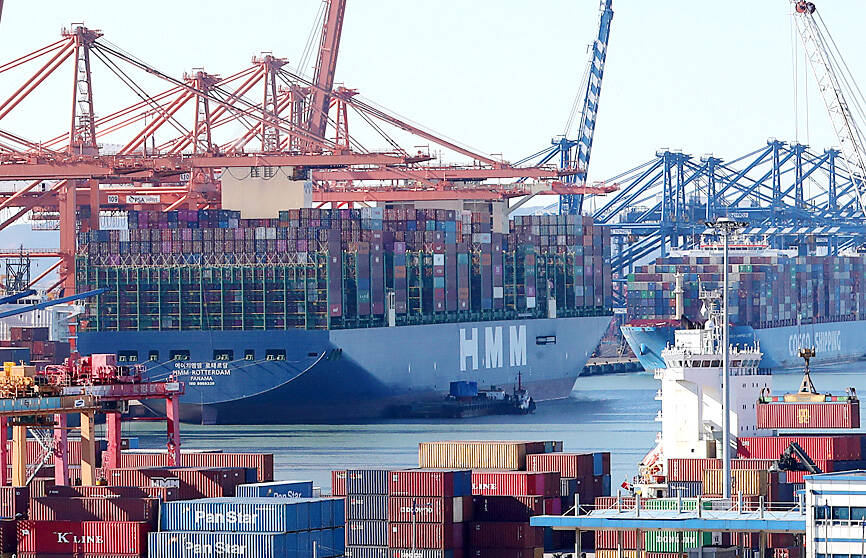The South Korean economy last quarter shrank for the first time since the beginning of the COVID-19 pandemic, an outcome that bolsters predictions that the central bank is likely to cease interest rate hikes for the short term.
The nation’s GDP contracted 0.4 percent from the previous three months as exports fell and consumer spending edged down, the Bank of Korea said yesterday.
However, the economy expanded by 1.4 percent from a year earlier.

Photo: EPA-EFE
Bank of Korea Governor Rhee Chang-yong had flagged the possibility of a contraction earlier this month when he delivered a quarter percentage-point interest rate increase.
Recent weakness in economic activity prompted markets to interpret the hike as the final move in the current tightening cycle.
The economy last year expanded 2.6 percent from a year earlier, in line with an earlier central bank projection.
The fourth-quarter setback for the economy is an indication of the difficulty of taming inflation with higher borrowing costs while also trying to secure a soft landing amid a global slowdown.
“Rates, oil prices and inflation have all contributed to hurt consumption,” KB Kookmin Bank chief economist Chang Jae-chul said. “It’s a very difficult situation.”
Regardless, the temptation to resort to an extra budget to shore up the economy should be treated with much caution, Chang said.
Officials and economists largely expect the economy to rebound without the need for a round of extra spending from the government. The strength of China’s economic recovery is likely to be a key factor for exports, while developments in the property market number among the areas of concern at home.
South Korean Minister of Finance Choo Kyung-ho acknowledged yesterday that the economy faces a “very difficult period” in the first half of the year.
South Korea serves as an early indicator of the state of the global economy given that it depends heavily on international trade. The nation’s performance is closely connected to those of major economies including China, the US and Japan.
South Korea is also vulnerable to fluctuations in global commodity prices, as it relies heavily on imports of oil and food.
As rates climbed worldwide, companies reined in investment, reducing demand for the nations products, such as semiconductors, steel and displays.
An economic slowdown in China particularly hurt South Korean exports last year. The government in Seoul is also concerned about the potential effects of growing US curbs on China over chip exports, given South Korea’s large chipmaking facilities there.
“Exports and their impact on Korea’s growth are top of mind for policymakers,” Pantheon Macroeconomics analyst Duncan Wrigley said after early trade data showed an ongoing decline in overseas shipments last week.
South Korean exports “will likely remain on a downward trend given the poor economic prospects in its major markets,” he said.
While trade is on a downturn, consumption is weakening in South Korea.
The nation’s economy is expected to grow slightly less than 1.7 percent, the central bank said, adding that inflation is estimated to reach 3.6 percent.
As the outlook darkens, the Bank of Korea is winding down its 18-month tightening cycle. The consensus among surveyed economists is that rate hikes are unlikely for the rest of this year.

The US dollar was trading at NT$29.7 at 10am today on the Taipei Foreign Exchange, as the New Taiwan dollar gained NT$1.364 from the previous close last week. The NT dollar continued to rise today, after surging 3.07 percent on Friday. After opening at NT$30.91, the NT dollar gained more than NT$1 in just 15 minutes, briefly passing the NT$30 mark. Before the US Department of the Treasury's semi-annual currency report came out, expectations that the NT dollar would keep rising were already building. The NT dollar on Friday closed at NT$31.064, up by NT$0.953 — a 3.07 percent single-day gain. Today,

‘SHORT TERM’: The local currency would likely remain strong in the near term, driven by anticipated US trade pressure, capital inflows and expectations of a US Fed rate cut The US dollar is expected to fall below NT$30 in the near term, as traders anticipate increased pressure from Washington for Taiwan to allow the New Taiwan dollar to appreciate, Cathay United Bank (國泰世華銀行) chief economist Lin Chi-chao (林啟超) said. Following a sharp drop in the greenback against the NT dollar on Friday, Lin told the Central News Agency that the local currency is likely to remain strong in the short term, driven in part by market psychology surrounding anticipated US policy pressure. On Friday, the US dollar fell NT$0.953, or 3.07 percent, closing at NT$31.064 — its lowest level since Jan.

The New Taiwan dollar and Taiwanese stocks surged on signs that trade tensions between the world’s top two economies might start easing and as US tech earnings boosted the outlook of the nation’s semiconductor exports. The NT dollar strengthened as much as 3.8 percent versus the US dollar to 30.815, the biggest intraday gain since January 2011, closing at NT$31.064. The benchmark TAIEX jumped 2.73 percent to outperform the region’s equity gauges. Outlook for global trade improved after China said it is assessing possible trade talks with the US, providing a boost for the nation’s currency and shares. As the NT dollar

The Financial Supervisory Commission (FSC) yesterday met with some of the nation’s largest insurance companies as a skyrocketing New Taiwan dollar piles pressure on their hundreds of billions of dollars in US bond investments. The commission has asked some life insurance firms, among the biggest Asian holders of US debt, to discuss how the rapidly strengthening NT dollar has impacted their operations, people familiar with the matter said. The meeting took place as the NT dollar jumped as much as 5 percent yesterday, its biggest intraday gain in more than three decades. The local currency surged as exporters rushed to